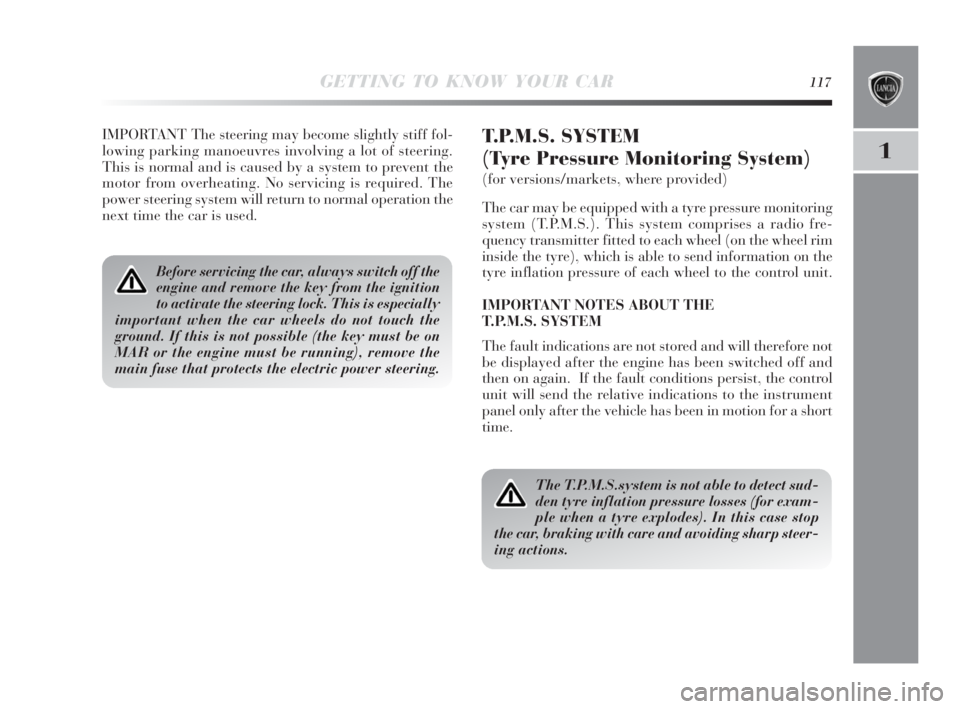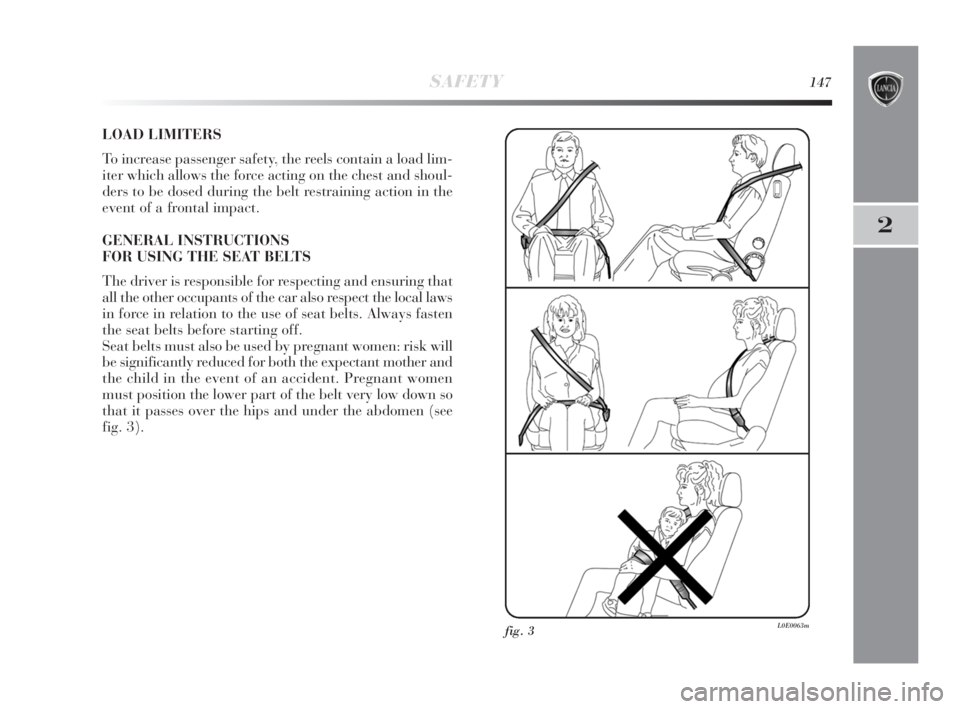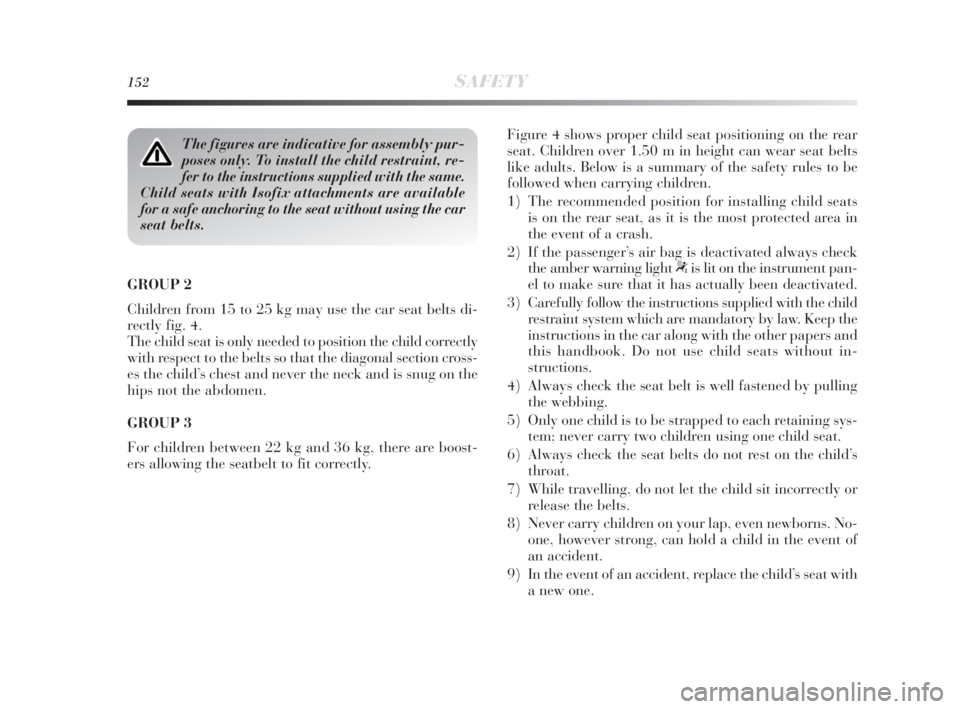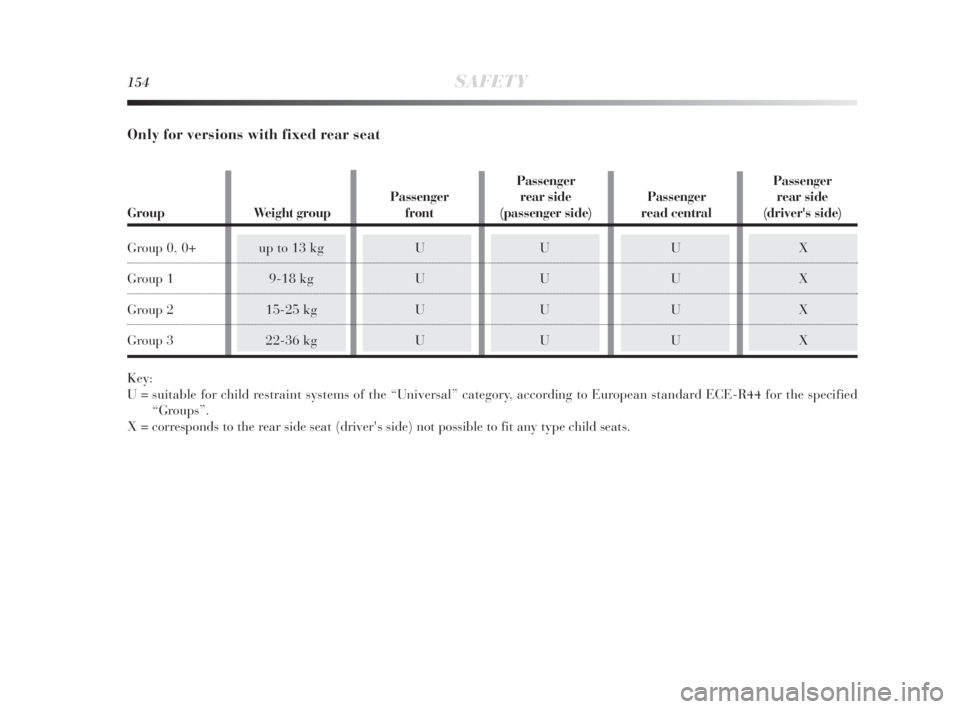ESP Lancia Delta 2010 Owner handbook (in English)
[x] Cancel search | Manufacturer: LANCIA, Model Year: 2010, Model line: Delta, Model: Lancia Delta 2010Pages: 276, PDF Size: 5.31 MB
Page 116 of 276

GETTING TO KNOW YOUR CAR115
1
EOBD SYSTEM
The EOBD system (European On Board Diagnosis) pro-
vides a continuous diagnosis of the emission-related com-
ponents. It also alerts the driver, by turning on the
U
warning light on the instrument panel together with a mes-
sage on the reconfigurable multifunctional display, when
these components are no longer in peak condition (see “In-
strument panel warning lights”).
The objective is:
❍to keep system efficiency under control;
❍to signal a fault which causes emission levels to in-
crease;
❍to signal the need to replace deteriorated components.
The system also has a diagnostic connector that can be in-
terfaced with appropriate tools, which makes it possible
to read the error codes stored in the control unit together
with a series of specific parameters for engine operation
and diagnosis.
This check can also be carried out by the traffic police.
IMPORTANT After eliminating the problem, to check the
system completely, Lancia Dealerships are obliged to run
a bench test and, if necessary, road tests which may also
call for a long journey.
Go to a Lancia Dealership as soon as pos-
sible if warning light
Ueither does not light
up when the key is turned to MAR or if,
while travelling, the warning light comes on either
steadily or blinking (along with a message on the
reconfigurable multifunctional display). The op-
eration of warning light
Umay be checked by the
traffic police using specific devices. Respect the
laws in force in the country where you are driving.
“DUALDRIVE” ELECTRIC POWER
STEERING SYSTEM
This is an electrically controlled power steering system
called “Dualdrive”. It is only operational with the ignition
key turned to MAR and the engine running; it can be cus-
tomised by the driver according to the driving conditions.
IMPORTANT If the ignition key is turned very quickly,
it may take 1-2 seconds before full power steering func-
tionality can be achieved.
001-142 Delta 3ed gb 30-11-2009 11:22 Pagina 115
Page 118 of 276

GETTING TO KNOW YOUR CAR117
1
IMPORTANT The steering may become slightly stiff fol-
lowing parking manoeuvres involving a lot of steering.
This is normal and is caused by a system to prevent the
motor from overheating. No servicing is required. The
power steering system will return to normal operation the
next time the car is used.T.P.M.S. SYSTEM
(Tyre Pressure Monitoring System)
(for versions/markets, where provided)
The car may be equipped with a tyre pressure monitoring
system (T.P.M.S.). This system comprises a radio fre-
quency transmitter fitted to each wheel (on the wheel rim
inside the tyre), which is able to send information on the
tyre inflation pressure of each wheel to the control unit.
IMPORTANT NOTES ABOUT THE
T.P.M.S. SYSTEM
The fault indications are not stored and will therefore not
be displayed after the engine has been switched off and
then on again. If the fault conditions persist, the control
unit will send the relative indications to the instrument
panel only after the vehicle has been in motion for a short
time.
Before servicing the car, always switch off the
engine and remove the key from the ignition
to activate the steering lock. This is especially
important when the car wheels do not touch the
ground. If this is not possible (the key must be on
MAR or the engine must be running), remove the
main fuse that protects the electric power steering.
The T.P.M.S.system is not able to detect sud-
den tyre inflation pressure losses (for exam-
ple when a tyre explodes). In this case stop
the car, braking with care and avoiding sharp steer-
ing actions.
001-142 Delta 3ed gb 30-11-2009 11:22 Pagina 117
Page 123 of 276

122GETTING TO KNOW YOUR CAR
❍The sensor detects objects that are not there (“echo dis-
turbance”) caused by mechanical disturbances, for ex-
ample: washing the car, rain (extreme wind condi-
tions), hail.
❍The indications sent by the sensor can also be altered
by the presence of ultrasound devices (e.g. pneumat-
ic brake systems or pneumatic drills) near the car.
❍Parking sensor system performance can also be influ-
enced by the position of the sensors, for example due to
a change in the ride setting (caused by wear to the shock
absorbers, suspension), or by overloading the vehicle and
carrying out specific tuning operations that require the
vehicle to be lowered. The ultimate responsibility when parking
and carrying out other dangerous manoeu-
vres still rests with the driver. When park-
ing, make sure that no-one is standing in the area,
especially children or animals. Parking sensors are
designed to assist drivers: in all cases, you must al-
ways pay the utmost attention during potentially
dangerous manoeuvres, even when these are carried
out a low speed.
001-142 Delta 3ed gb 30-11-2009 11:22 Pagina 122
Page 124 of 276

GETTING TO KNOW YOUR CAR123
1
MAGIC PARKING
(for versions/markets, where provided)
The Magic Parking system notifies the driver of a free par-
allel parking space that is a suitable length for the vehi-
cle; it helps the driver when manoeuvring by automati-
cally managing the movement of the steering wheel.During the manoeuvre the driver is also assisted by infor-
mation from the parking sensors (4 front and 4 rear) which
provide further distance information when approaching
obstacles in front of and behind the vehicle.
When looking for a parking space it is helpful if the front
and rear sensors are not activated, whilst during the ma-
noeuvre, the front and rear sensors will be automatically
activated when reverse gear is engaged.
The ultimate responsibility when parking,
however, always rests with the driver. Dur-
ing the entire manoeuvre it it always neces-
sary to make sure that there are no people or ani-
mals in the space.
Parking sensors are designed to assist drivers:
in all cases, you must always pay the utmost
attention during potentially dangerous ma-
noeuvres, even when these are carried out a low
speed: the Magic Parking system does NOT in nay
way adjust the speed of the vehicle during the ma-
noeuvre, the control of the acceleration speed and
braking remain the responsibility of the driver.
001-142 Delta 3ed gb 30-11-2009 11:22 Pagina 123
Page 128 of 276

GETTING TO KNOW YOUR CAR127
1
❍a parking space more than about 130 cm longer than
the dimensions of the vehicle:parking can take place in
several manoeuvres of which only the first takes place with
automatic management of the steering (the subsequent ma-
noeuvres are entirely the responsibility of the driver).
To chose the side on which to search and carry out the ma-
noeuvre, the driver can;
1)
DChoose to carry out the search for the space and
the manoeuvre on the passenger side with:
❍the direction indicator in the middle position;
❍the hazard warning lights on;
❍the hazard warning lights on and the direction indi-
cator in the passenger side position;
❍the direction indicator pointing towards the passenger
side.
2)
FChoose to carry out the search for the space and
the manoeuvre on the driver’s side with:
❍the direction indicator in the driver’s side position;
❍the hazard warning lights on and the direction indi-
cator in the driver’s side position.
The system will notify the driver, on the side in which
the search and the manoeuvre are taking place by means
of dedicated messages in the instrument panel display and
the symbol (
Fand
D) different on the right and left sides. The search will, however, take place on both sides, there-
fore it is possible to make the selection using the direc-
tion indicators even when having just driven past a park-
ing space that is deemed suitable.
During the search stage the speed should be less than
around 30 km/h; if a speed of about 25 km/h is reached
the driver will be advised to decrease the speed, if a speed
of about 30 km/h is exceeded, the system will be deacti-
vated; in this case the system should be reactivated by
pressing button A-fig. 77.
If the Lane Change function is activated (see chapter 1
in the Exterior lights) the search for the parking space
always takes place on the passenger side.
If the parking sensors are activated during the search for
a parking space (see “Front and rear parking sensors”
chapter), the operation of the Magic Parking system is de-
activated.
The manoeuvres of searching for a parking
space and carrying out the parking manoeu-
vre should be carried out following the High-
way Code.
001-142 Delta 3ed gb 30-11-2009 11:22 Pagina 127
Page 130 of 276

GETTING TO KNOW YOUR CAR129
1
If the driver carries out a voluntary or involuntary action
on the steering during the parking manoeuvre (touching it
or preventing its movement), the manoeuvre will be in-
terrupted.
If the road surface is very uneven or there are obstacles un-
der the wheels affecting the movement of the vehicle, pre-
venting it from continuing along the correct trajectory, the
manoeuvre may be interrupted.
Conclusion of manoeuvre
If the size of parking space permits, the parking manoeu-
vre may be performed in one go, when reverse gear is re-
leased the wheels will be realigned and the manoeuvre will
be considered completed and the system will consequent-
ly be deactivated. If the size of the parking space is small-
er, it may take several manoeuvres, the driver will be ad-
vised to complete the parking manoeuvre manually via a
dedicated messages in the instrument panel display. General warnings
❍The ultimate responsibility when parking and carrying
out other dangerous manoeuvres always rests with the dri-
ver. Always make sure that there are no people, animals or
objects in the way when carrying out these manoeuvres.
The Magic Parking system (like parking sensors) is de-
signed to assist drivers: in all cases, you must always pay
the utmost attention during potentially dangerous ma-
noeuvres, even when these are carried out a low speed:
❍If the sensors are affected by impacts that alter their
position, the operation of the system may be greatly re-
duced.
❍If the sensors are dirty, covered in snow, ice, mud or
paint, the operation of the system could be greatly reduced.
❍It is vital that the sensors are always clean in order for
the system to work properly. Take great care when clean-
ing the sensors not to scratch or damage them; avoid us-
ing dry, rough or hard cloths. The sensors should be washed
with clean water with possibly some car shampoo added.
In washing stations, clean the sensors quickly, keeping the
steam jet/high pressure washing nozzles at least 10 cm
away from the sensors.
If you wish to stop the steering wheel with
your hands during a manoeuvre, it is advis-
able to handle it firmly on the outer rim. Do
not try and keep your hands on the inside or hold
the actual spokes.
001-142 Delta 3ed gb 30-11-2009 11:22 Pagina 129
Page 135 of 276

134GETTING TO KNOW YOUR CAR
fig. 82L0E0249m
The ultimate responsibility when parking
and carrying out other dangerous manoeu-
vres still rests with the driver. When parking, make
sure that no-one is standing in the area, especially
children or animals. Parking sensors are designed
to assist drivers: in all cases, you must always pay
the utmost attention during potentially dangerous
manoeuvres, even when carried out at low speed.
Version with 8 sensors
On the version with 4 front sensors and 4 rear sensors, the
system is activated when reverse gear is engaged or by
pressing the button fig. 8. If there has been a request to
activate the Magic Parking system, the front and rear sen-
sors are not automatically activated during the search for
a parking space, but can be activated by pressing the spe-
cial button (fig. 82) or by engaging reverse gear when
the speed is below around 15 km/h.
When reverse gear is released, the front and rear sensors
remain activated until a speed of around 15 km/h is ex-
ceeded to allow the parking manoeuvre to be completed.
The system can also be activated by pressing the button
fig. 82 in the centre panel: a warning light in the button
comes on when the system is activated.
The sensors are deactivated by pressing the button again
fig. 82 or when a speed of 15 km/h is exceeded: the warn-ing light in the button remains off when the system is not
activated.
When the sensors are activated, the system starts to pro-
duce acoustic signals from the front or rear buzzers as soon
as an obstacle is detected with the frequency increasing as
the obstacle gets closer.
When the obstacle is less than about 30 cm away, the
sound becomes continuous. Depending on the position of
the obstacle (in front or behind) the sound is produced by
the corresponding buzzers (front or rear). The obstacle
closest to the vehicle is signalled.
The acoustic signal stops immediately if the distance of
the obstacle increases. The sound cycle remains constant
if the distance measured by the centre sensors remains un-
changed, whilst if this situation occurs for the side sen-
sors, the signal is interrupted after about 3 seconds (for
example, to prevent signals in the case of manoeuvres
alongside walls).
001-142 Delta 3ed gb 30-11-2009 11:22 Pagina 134
Page 148 of 276

SAFETY147
2
LOAD LIMITERS
To increase passenger safety, the reels contain a load lim-
iter which allows the force acting on the chest and shoul-
ders to be dosed during the belt restraining action in the
event of a frontal impact.
GENERAL INSTRUCTIONS
FOR USING THE SEAT BELTS
The driver is responsible for respecting and ensuring that
all the other occupants of the car also respect the local laws
in force in relation to the use of seat belts. Always fasten
the seat belts before starting off.
Seat belts must also be used by pregnant women: risk will
be significantly reduced for both the expectant mother and
the child in the event of an accident. Pregnant women
must position the lower part of the belt very low down so
that it passes over the hips and under the abdomen (see
fig. 3).
fig. 3L0E0063m
143-164 Delta 4ed gb 12-02-2010 10:20 Pagina 147
Page 153 of 276

152SAFETY
GROUP 2
Children from 15 to 25 kg may use the car seat belts di-
rectly fig. 4.
The child seat is only needed to position the child correctly
with respect to the belts so that the diagonal section cross-
es the child’s chest and never the neck and is snug on the
hips not the abdomen.
GROUP 3
For children between 22 kg and 36 kg, there are boost-
ers allowing the seatbelt to fit correctly.Figure 4 shows proper child seat positioning on the rear
seat. Children over 1.50 m in height can wear seat belts
like adults. Below is a summary of the safety rules to be
followed when carrying children.
1) The recommended position for installing child seats
is on the rear seat, as it is the most protected area in
the event of a crash.
2) If the passenger’s air bag is deactivated always check
the amber warning light “is lit on the instrument pan-
el to make sure that it has actually been deactivated.
3) Carefully follow the instructions supplied with the child
restraint system which are mandatory by law. Keep the
instructions in the car along with the other papers and
this handbook. Do not use child seats without in-
structions.
4) Always check the seat belt is well fastened by pulling
the webbing.
5) Only one child is to be strapped to each retaining sys-
tem; never carry two children using one child seat.
6) Always check the seat belts do not rest on the child’s
throat.
7) While travelling, do not let the child sit incorrectly or
release the belts.
8) Never carry children on your lap, even newborns. No-
one, however strong, can hold a child in the event of
an accident.
9) In the event of an accident, replace the child’s seat with
a new one.
The figures are indicative for assembly pur-
poses only. To install the child restraint, re-
fer to the instructions supplied with the same.
Child seats with Isofix attachments are available
for a safe anchoring to the seat without using the car
seat belts.
143-164 Delta 4ed gb 12-02-2010 10:20 Pagina 152
Page 155 of 276

154SAFETY
Only for versions with fixed rear seat
Key:
U = suitable for child restraint systems of the “Universal” category, according to European standard ECE-R44 for the specified
“Groups”.
X = corresponds to the rear side seat (driver's side) not possible to fit any type child seats.
Passenger Passenger
Passenger rear side Passenger rear side
Group Weight group front (passenger side) read central (driver's side)
Group 0, 0+ up to 13 kg U U U X
Group 1 9-18 kg U U U X
Group 2 15-25 kg U U U X
Group 3 22-36 kg U U U X
143-164 Delta 4ed gb 12-02-2010 10:20 Pagina 154